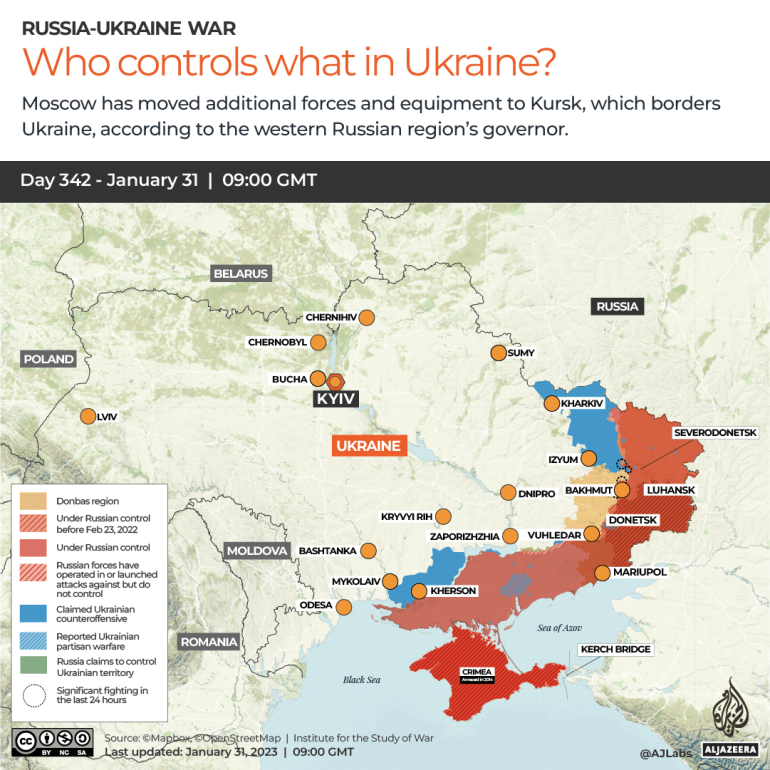Russia says it has captured a village on the northern outskirts of Bakhmut as it intensifies efforts to surround the front-line city in Ukraine’s eastern Donetsk region.
The village of Blahodatne, which is about five kilometres (three miles) north of Bakhmut, was captured with the help of aerial support, the Russian defence ministry said in a statement on Tuesday.
There was no immediate response from Ukraine’s government, and Al Jazeera could not independently verify the account.
The announcement came three days after the head of Russia’s Wagner Group said the mercenary force had seized Blahodatne in an attack Ukraine said it had repelled.

Capturing Bakhmut, which had a pre-war population of about 75,000 people, would be Russia’s first major battleground achievement since it took the cities of Severodonetsk and Lysychansk in July.
Regional Governor Pavlo Kyrylenko said two civilians, including a boy, were killed in a Russian artillery attack on Bakhmut on Tuesday.
Russian forces have made several advances in the area in recent weeks, notably capturing the salt-mining town of Soledar to Bakhmut’s north.
Earlier this month, Russia also claimed it had captured Klishchiivka, a village in Ukraine’s Donetsk region, which had a pre-war population of about 400 people. The village sits about nine kilometres (six miles) south of Bakhmut.
This week, a large Russian force launched an assault against the Ukrainian-held bastion of Vuhledar, further south along the same eastern front. Russian officials have claimed to have gained a foothold there, but Kyiv says it has largely repelled that attack so far.
Military centres in Belarus
Meanwhile, Russian President Vladimir Putin on Tuesday backed a plan to set up joint military training centres with Belarus, reigniting speculation that forces from the neighbouring country could join his troops in Ukraine.
In a decree, Putin tasked the defence and foreign ministers to conduct talks with Belarus and sign an agreement to establish the facilities.
The document did not specify where the centres would be based. Minsk allowed Moscow to use Belarusian territory as a launching pad for its Ukraine offensive that began on February 24 last year.
For months, Belarus’s longtime leader Alexander Lukashenko has insisted that he will not send troops into Ukraine despite increasing military cooperation with Russia.

Earlier this month, the two countries launched joint air force drills in Belarus that are scheduled to last until February 1.
“Some experts say the exercises could be a diversion tactic to lure Ukrainian forces away from the frontlines in the east and south,” said Al Jazeera’s Natacha Butler, reporting from near the Ukraine-Belarus border, where Ukrainian forces have been training amid a potential threat military threat from Belarus.
“Few people here expected this war and no one pretends they know what Moscow is planning. But they are watching closely and say they are ready.”
France to send more weapons
Separately, defence minister Sebastien Lecornu said on Tuesday that France will send 12 further Caesar truck-mounted howitzers to Ukraine to help in the fight against Russia.
The artillery pieces, adding to 18 already delivered, would be financed from a 200-million-euro ($217m) fund set up by France after Russia’s invasion, Lecornu said in a joint news conference with his Ukrainian counterpart, Oleksiy Reznikov, in Paris.
Alongside other Western-supplied mobile cannon such as the German Panzerhaubitze 2000, the Caesar was credited last year with helping Ukraine attack targets deep behind Russian lines, undermining Moscow’s offensive.
The truck-mounted 155mm guns can set up, fire a highly-accurate volley at ranges of up to 40km (25 miles) and shift position before the enemy can locate them and fire back.
Lecornu said the new batch of howitzers would be delivered in the coming weeks.
Denmark has also pledged its entire existing 19-strong fleet of the French-made howitzers to the Ukrainian war effort.


